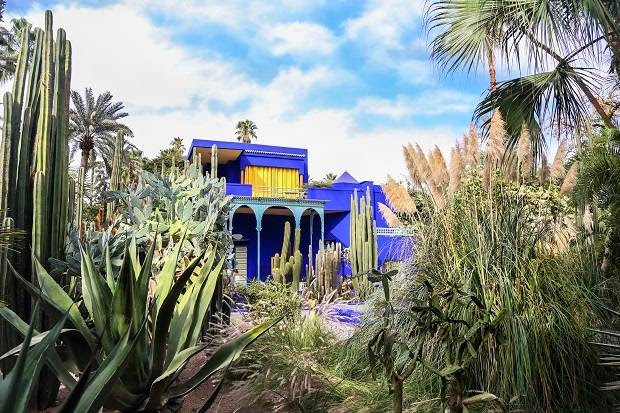NZ Herald
By: Kate Haywood
Lose yourself in the colour and charm of this ancient city, writes Kate Haywood.
Alcohol is not readily available in Marrakech. No matter, because this chaotic and exotic melting-pot of civilisations is still completely intoxicating. Here’s how to fill your cup and drink it up in the Jewel of Morocco.
A botanical garden and artist’s landscape garden in Marrakech, Morocco. Photo / Getty Images
Stay in the heart of the medina in a beautiful riad.
After a stuffy seven-hour train ride from Fez, I could have cried with happiness when I was greeted with mint tea and spiced almond biscuits on arrival at the wonderfully cool and chic Riad Adika. This hidden gem is just one of the many hundreds of riads — traditional Moroccan houses built around a central courtyard — that have been converted into guesthouses offering visitors to Marrakech an atmospheric, historic and uniquely Moroccan accommodation experience.
Ideally located within the walls of Marrakech’s ancient medina (old town), Riad Adika boasts eight spacious rooms and suites set around a large, light-filled central interior courtyard, the focal point of which is the tiled turquoise plunge pool.
It was by the pool, on the comfortable yet stylish seating, that I came across the rest of my group, who had been lounging there since arriving hours earlier (having wisely chosen the relative convenience of flying over the “romanticism” of rail travel).
“This”, declared one friend rather dramatically, “is the only palace I need to visit today.”
Rooms at Riad Adika start from $150 for two, including breakfast.
Also recommended are Riad Porte Royale and Riad Yasmine.
Dine where the setting is as stunning as the food on your plate
Boasting 350 days of sunshine per year, Marrakech is made for al fresco dining. Many of the best places to eat are to be found on shaded rooftop terraces overlooking the souks, or nestled away in luxurious gardens, appropriately striking settings for sampling one of the world’s most delicious and diverse cuisines.
The rooftop terrace setting of Nomad, with its Scandi-meets-North Africa design and views of the Place des Epices, Koutoubia Mosque and the Atlas mountains in the distance, is hard to beat, and arriving at sunset is a must.
Rooftop restaurants and cafes give a great panorama of Marrakesh and the old medina. Photo / Getty Images
Nomad is trendy, and certainly caters to a tourist crowd (albeit a particularly stylish tourist crowd), but the “Modern Moroccan” cuisine on offer more than lives up to the hype. We went for the Nomad Couscous (slowly braised preserved lemon and spice-infused beef served over seasonal vegetables on a bed of couscous, $20) and the saffron-scented Moroccan date cake with whipped cream and salted caramel for dessert ($11).
● nomadmarrakech.com
Other must-visit destinations include the terrace of “cross-cultural” Cafe Clock (try a camel burger, $14.75), the garden of the aptly-named Le Jardin (relax over a date milkshake, $4.75), and under the banana and olive trees at La Famille (detox from all those lamb tagines with the prettiest vegetarian food in Marrakech).
● marrakech.cafeclock.com; lejardinmarrakech.com
Shop in a place where the locals have been haggling for more than 1000 years
The traditional Arab markets, or souks, of the Marrakech medina are a labyrinth-like network of narrow alleyways and small streets, where haggling is both expected and an art form. The hectic main thoroughfares of Souq Semmarine and Souq el-Kebir sell anything and everything, but there are specialised souks organised into traditional commodities. Swing by the Slipper Souk to pick up babouches (traditional Moroccan leather slippers favoured by Vogue) and the Spice Souk to admire artful displays of ginger, turmeric, cinnamon, and saffron. Give haggling your best shot by exchanging pleasantries before inquiring about the price, making a counter-offer of half of what you are prepared to pay, and deploying feigned disinterest as and when required.
Those who prefer set-price shopping should head to Chabi Chic for stylish, handmade, Moroccan kitchenware, Riad Yima for contemporary art from the “Andy Warhol of Marrakech”, and Panier Morrocain for personalised beach baskets. The Ensemble Artisanal Marrakech, a government-sponsored complex of artisanal workshops selling high-quality handcrafted goods at reasonable fixed prices, is also worth a visit (if only to suss out the prices before heading back to the souks for your next round of negotiations).
Spices in the Souk. Photo / Getty Images
Explore the Marrakech of Yves Saint Laurent
Standing in front of the Villa Oasis, with its brilliant bright blue finish, in the grounds of the Eden-like Jardin Majorelle, it’s easy to see why the famous French designer Yves Saint Laurent once declared “Marrakech taught me colour”. Saint Laurent acquired the Jardin Majorelle in 1980, having been a frequent visitor to the villa and the gardens since his first trip to Marrakech in the 1960s. Today, the grounds are home to the designer’s memorial, and one of the most visited sites in Morocco (go early).
● jardinmajorelle.com/ang
Adjoining the Jardin Majorelle on the Rue Yves Saint Laurent is YSL Marrakech (admission $15), one of two brand new museums exclusively dedicated to the life and work of Saint Laurent (the other is in Paris) and Marrakech’s most fashionable new attraction. Five thousand pieces of clothing and 15,000 accessories are displayed across the Marrakech and Paris museums, including every piece of every haute couture collection made by the designer between 1962 and 2002, as well as 65 Dior pieces designed during Saint Laurent’s tenure as Christian Dior’s assistant between 1955 and 1960.
● museeyslmarrakech.com/en







